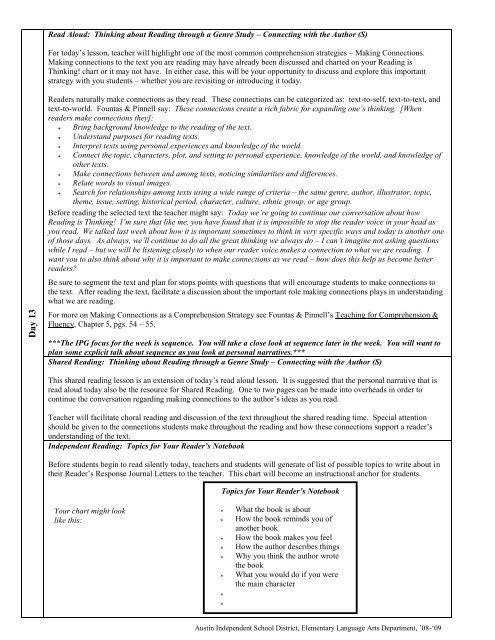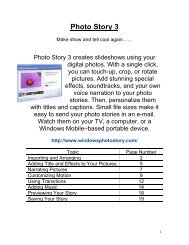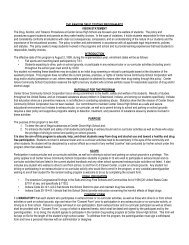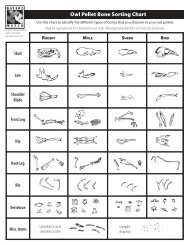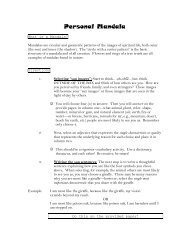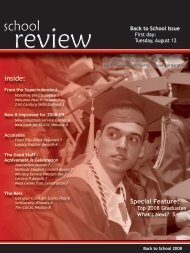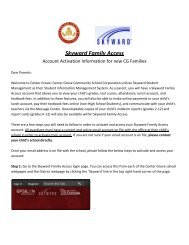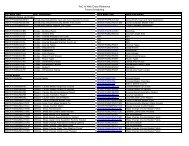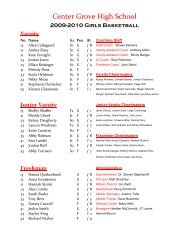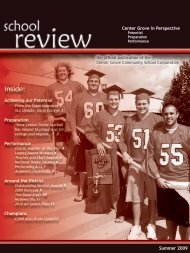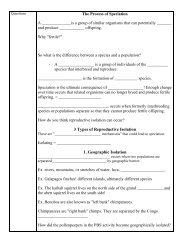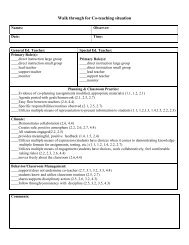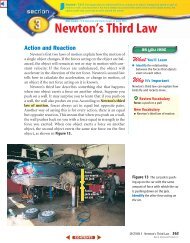The First 20 Days of Reading: Intermediate - Center Grove ...
The First 20 Days of Reading: Intermediate - Center Grove ...
The First 20 Days of Reading: Intermediate - Center Grove ...
You also want an ePaper? Increase the reach of your titles
YUMPU automatically turns print PDFs into web optimized ePapers that Google loves.
Day 13<br />
Read Aloud: Thinking about <strong>Reading</strong> through a Genre Study – Connecting with the Author (S)<br />
For today‟s lesson, teacher will highlight one <strong>of</strong> the most common comprehension strategies – Making Connections.<br />
Making connections to the text you are reading may have already been discussed and charted on your <strong>Reading</strong> is<br />
Thinking! chart or it may not have. In either case, this will be your opportunity to discuss and explore this important<br />
strategy with you students – whether you are revisiting or introducing it today.<br />
Readers naturally make connections as they read. <strong>The</strong>se connections can be categorized as: text-to-self, text-to-text, and<br />
text-to-world. Fountas & Pinnell say: <strong>The</strong>se connections create a rich fabric for expanding one’s thinking. [When<br />
readers make connections they]:<br />
Bring background knowledge to the reading <strong>of</strong> the text.<br />
Understand purposes for reading texts.<br />
Interpret texts using personal experiences and knowledge <strong>of</strong> the world.<br />
Connect the topic, characters, plot, and setting to personal experience, knowledge <strong>of</strong> the world, and knowledge <strong>of</strong><br />
other texts.<br />
Make connections between and among texts, noticing similarities and differences.<br />
Relate words to visual images.<br />
Search for relationships among texts using a wide range <strong>of</strong> criteria – the same genre, author, illustrator, topic,<br />
theme, issue, setting, historical period, character, culture, ethnic group, or age group.<br />
Before reading the selected text the teacher might say: Today we’re going to continue our conversation about how<br />
<strong>Reading</strong> is Thinking! I’m sure that like me, you have found that it is impossible to stop the reader voice in your head as<br />
you read. We talked last week about how it is important sometimes to think in very specific ways and today is another one<br />
<strong>of</strong> those days. As always, we’ll continue to do all the great thinking we always do – I can’t imagine not asking questions<br />
while I read – but we will be listening closely to when our reader voice makes a connection to what we are reading. I<br />
want you to also think about why it is important to make connections as we read – how does this help us become better<br />
readers<br />
Be sure to segment the text and plan for stops points with questions that will encourage students to make connections to<br />
the text. After reading the text, facilitate a discussion about the important role making connections plays in understanding<br />
what we are reading.<br />
For more on Making Connections as a Comprehension Strategy see Fountas & Pinnell‟s Teaching for Comprehension &<br />
Fluency, Chapter 5, pgs. 54 – 55.<br />
***<strong>The</strong> IPG focus for the week is sequence. You will take a close look at sequence later in the week. You will want to<br />
plan some explicit talk about sequence as you look at personal narratives.***<br />
Shared <strong>Reading</strong>: Thinking about <strong>Reading</strong> through a Genre Study – Connecting with the Author (S)<br />
This shared reading lesson is an extension <strong>of</strong> today‟s read aloud lesson. It is suggested that the personal narrative that is<br />
read aloud today also be the resource for Shared <strong>Reading</strong>. One to two pages can be made into overheads in order to<br />
continue the conversation regarding making connections to the author‟s ideas as you read.<br />
Teacher will facilitate choral reading and discussion <strong>of</strong> the text throughout the shared reading time. Special attention<br />
should be given to the connections students make throughout the reading and how these connections support a reader‟s<br />
understanding <strong>of</strong> the text.<br />
Independent <strong>Reading</strong>: Topics for Your Reader’s Notebook<br />
Before students begin to read silently today, teachers and students will generate <strong>of</strong> list <strong>of</strong> possible topics to write about in<br />
their Reader‟s Response Journal Letters to the teacher. This chart will become an instructional anchor for students.<br />
Topics for Your Reader’s Notebook<br />
Your chart might look<br />
like this:<br />
What the book is about<br />
How the book reminds you <strong>of</strong><br />
another book<br />
How the book makes you feel<br />
How the author describes things<br />
Why you think the author wrote<br />
the book<br />
What you would do if you were<br />
the main character<br />
Austin Independent School District, Elementary Language Arts Department, ‟08-„09


